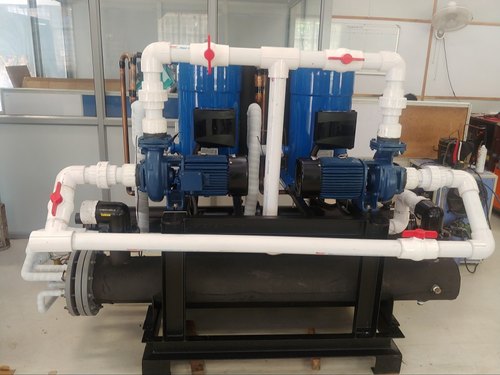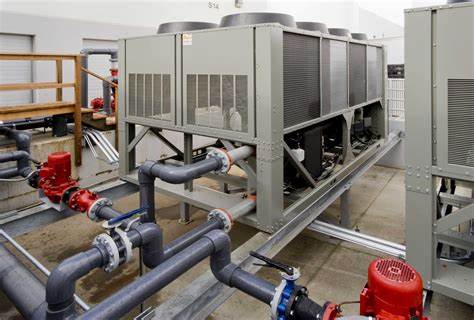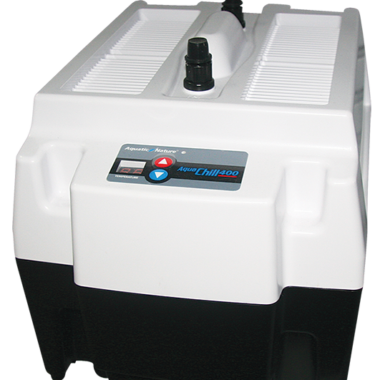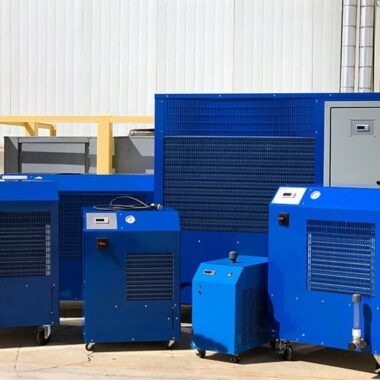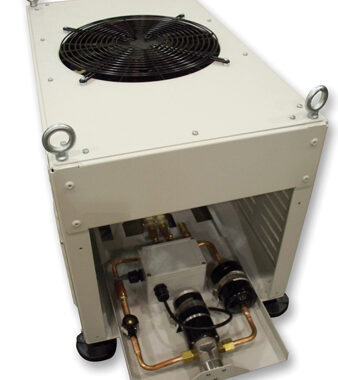Energy Efficiency in Industrial Chillers
Energy Efficiency in Industrial Chillers
Moving forward the energy proficiency of industrial chillers is basic for decreasing operational costs and minimizing environmental affect. Here are a few key techniques and contemplations for improving the energy efficiency of industrial chillers :
1. Proper Measuring and Selection
Description:
Selecting a chiller that’s appropriately measured for the particular cooling load requirements guarantees optimal execution and efficiency.
Key Points:
Load Coordinating: Avoid oversizing or undersizing by precisely calculating the cooling stack.
Part-Load Productivity: Choose chillers with tall efficiency at part-load conditions, as chillers regularly work at less than full capacity.
2. Customary Maintenance
Description:
Schedule maintenance guarantees that chillers work efficiently and dependably.
Key Points:
Cleaning: Routinely clean heat exchangers, filters, and condenser coils to preserve heat exchange efficiency.
Refrigerant Levels: Check and maintain legitimate refrigerant levels to maintain a strategic distance from inefficiencies.
Inspection: Inspect for leaks, worn components, and guarantee proper oil of moving parts.
3. Progressed Controls and Automation
Description:
Actualizing progressed control systems and computerization can optimize chiller operation and make strides energy proficiency.
Key Points:
Variable Speed Drives (VSDs): Utilize VSDs on compressors, pumps, and fans to alter speed based on request, decreasing energy utilization.
Building Administration Frameworks (BMS): Coordinated chillers with BMS to screen and control chiller operation based on real-time information.
Smart Controls: Utilize smart controls for energetic load administration and energy optimization.
4. Heat Recuperation
Description:
Recouping waste heat from chiller systems can be utilized for other forms, making strides in general energy proficiency.
Key Points:
Heat Recuperation Chillers: Actualize chillers outlined for heat recuperation to capture waste heat and utilize it for space heating or preheating handle water.
Cogeneration Systems: Coordinated with cogeneration systems to utilize recuperated heat for power generation or other applications.
5. Optimize Chilled Water System
Description:
Improving the productivity of the chilled water dispersion system improves overall chiller execution.
Key Points:
Temperature Reset: Alter chilled water set points based on real-time cooling demand.
Water Flow Control: Utilize variable flow systems to optimize water flow rates and decrease pumping energy.
Thermal Capacity: Execute thermal capacity systems to move cooling load to off-peak hours, decreasing top energy utilization.
6. Energy-Efficient Technologies
Description:
Embrace energy-efficient chiller advances to reduce energy consumption.
Key Points:
Attractive Bearing Compressors: Utilize magnetic bearing compressors for diminished friction and higher proficiency.
Absorption Chillers: Consider assimilation chillers for applications where waste heat or renewable energy sources are accessible.
High-Efficiency Motors: Utilize high-efficiency motors to drive compressors and fans.
7. System Optimization
Description:
Optimize the complete chiller plant system to move forward energy efficiency.
Key Points:
Plant Plan: Plan chiller plants with parallel chillers and proper arranging to maximize efficiency.
Pump Efficiency: Utilize productive pumps and optimize pump control techniques.
Cooling Towers: Guarantee cooling towers work proficiently by maintaining clean fill media and optimizing fan speed.
8. Monitoring and Benchmarking
Description:
Continuous observing and benchmarking help identify zones for enhancement and track energy productivity gains.
Key Points:
Energy Administration Frameworks: Actualize energy administration systems to screen chiller performance and energy utilize.
Performance Measurements: Track key performance pointers (KPIs) such as coefficient of execution (COP) and energy utilization escalated (EUI).
Regular Reviews: Conduct customary energy reviews to identify wasteful aspects and execute corrective actions.
Conclusion
Making strides the energy productivity of industrial chillers includes a combination of legitimate sizing and determination, customary support, progressed controls, heat recovery, system optimization, and nonstop checking. By actualizing these techniques, businesses can essentially decrease their energy utilization, lower working costs, and minimize their environmental impression.
